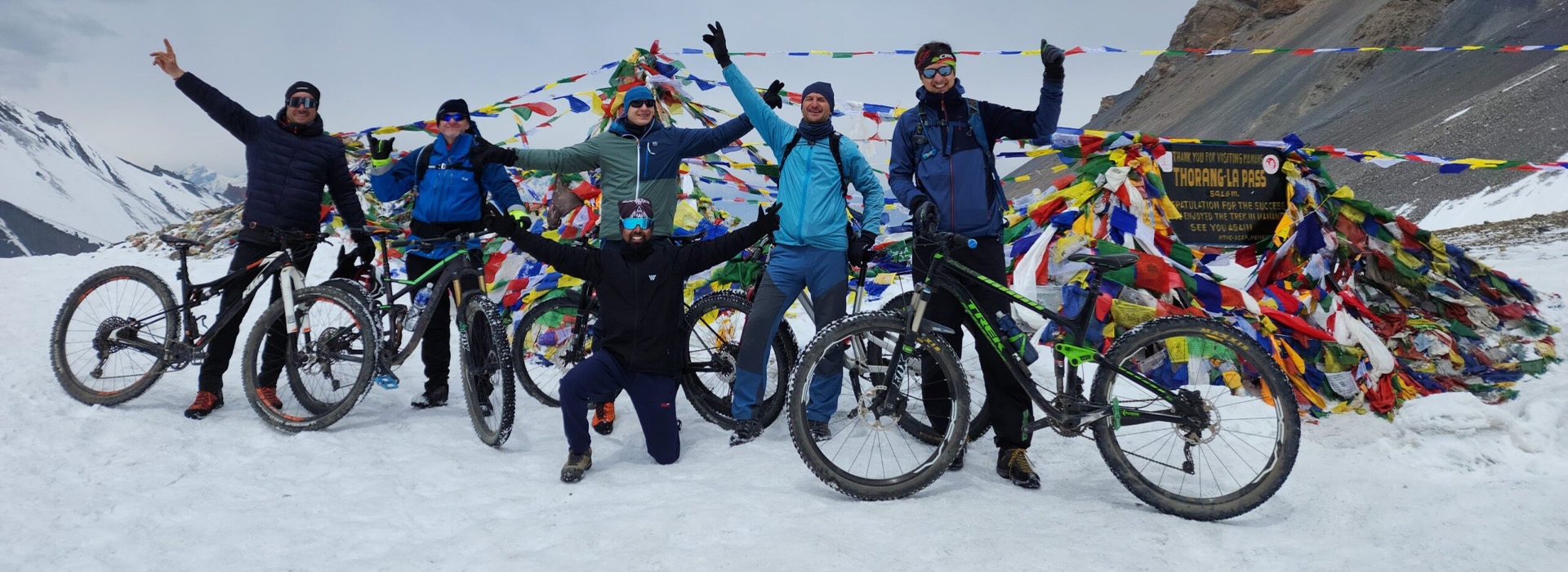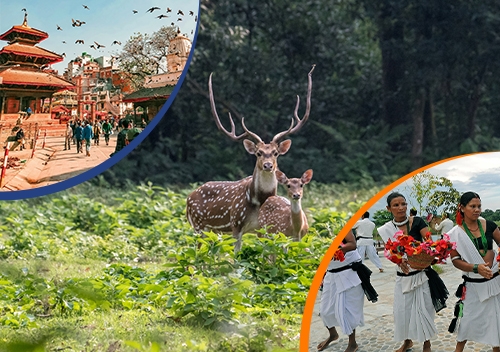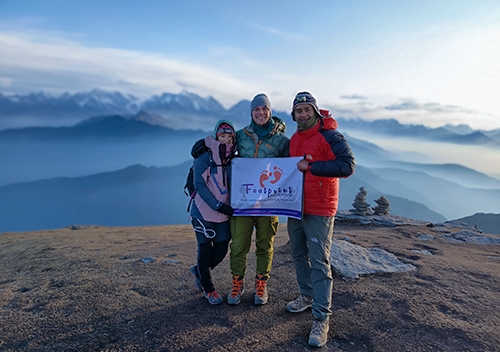Highlights of the Annapurna Circuit Bikepacking Route
- Ride through lush green valleys, alpine forests, barren high-altitude deserts, and traditional Himalayan villages.
- Challenge yourself to cross the thrilling Thorong La Pass at 5,416m, one of the highest navigable passes for bikers.
- Travel through rapidly changing climates, from warm tropical regions to snowy high-altitude terrains on a mountain bike
- Meet Gurung, Thakali, and Tibetan communities, experiencing their unique traditions, lifestyles, and authentic cuisines.
- Push your endurance and biking skills on rugged trails at extreme elevations.
- Enjoy the breathtaking vistas of Annapurna, Dhaulagiri, and Machhapuchhre as you ride through the circuit.
- Experience the wonder of biking through the world’s deepest gorge, nestled between Annapurna and Dhaulagiri massifs.
Bikepacking the Annapurna Circuit is an extraordinary adventure, ideal for seasoned cyclists seeking to test their endurance against the high-altitude challenges and experience one of the most dramatic landscapes in the world on their bikes. Spanning 12-14 days, covering around 280 km in distance, the Annapurna Circuit Cycling Route takes the cyclists from the lush forests through the rugged jeep tracks into an alpine desert, crossing one the highest mountain passes, Thorong La (5,416 meters).
A Beginner's Guide to Bikepacking the Annapurna Circuit, Nepal Skirting rugged trails, cultural immersion, and breathtaking Himalayan views, the Annapurna Circuit by Bike is an unrivaled adventure. For experienced cyclists and beginners alike, this bikepacking route is a great way to see Nepal's diverse landscapes.
Starting the journey from Besisahar, riders follow a jeep track to Manang, passing with the constant majestic backdrop of the Annapurna Massif. The trail becomes more challenging beyond Manang. Also often requiring the cyclists to carry their bikes through hike-a-bike terrain, especially as they cross through Thorong La. The pass itself includes a steep, off road winding route. Following the intense ascent, the descent to Muktinath is an easy and thrilling change, where the trail turns into a smooth single track path that leads riders swifty down to lower altitude. This route provides a well-deserved reward with an amazing view of the Kali Gandaki River Valley—the deepest river gorge in the world.
Despite the natural beauty and achievement, Bikepacking the Annapurna Circuit is not for beginners. Trekking to the Annapurna Circuit is itself a challenge, but bikepacking the whole route creates an additional challenge, the technical skill and a potential risk of high-altitude sickness.
The Annapurna Circuit (Bikepacking Route) Overview
Here’s a detailed breakdown of the essential statistics for the Annapurna Circuit Bikepacking Route:
| Attribute | Details |
Distance | Approximately 230–260 km (depending on variations and detours). |
| Days | 10–15 days (based on fitness level, weather, and acclimatization needs). |
| Unpaved Singletrack | Around 40–50% of the route consists of unpaved singletrack trails. |
| Rideable (Time) | 70–80% (some sections, like Thorong La Pass, may require walking/pushing). |
| Total Ascent | Approximately 15,000 meters (cumulative elevation gain). |
| High Point | Thorong La Pass at 5,416 meters (17,769 feet) above sea level. |
Difficulty (1–10) | 8–9 (due to altitude, technical sections, and challenging terrain). |
Most routes usually commence at Besisahar and are dubbed the Annapurna Circuit Bikepacking Route, whose course passes through some of the most fantastic terrain in Nepal.
Key segments include:
- Besisahar to Chame: A mix of challenging ascents and scenic river views.
- Chame to Manang: Pass through pine forests and get your first glimpses of Annapurna peaks.
- Manang to Thorong Phedi: Gear up for steep climbs as you ascend closer to the high-altitude pass.
- Thorong La Pass to Muktinath: The ultimate reward for your hard work—a stunning descent filled with sweeping mountain vistas.
- Muktinath to Tatopani: Ride past charming villages and hot springs, perfect for relaxing after a long day.
Why Choose the Annapurna Circuit Biking Trek?
The Annapurna Circuit Bikepacking Route is another rider’s paradise and an ideal place for biking and adventure. Travelling through valleys to mountains or high plateaus to desert this biking trek promises a pristine natural scenery and vibrant culture.
Here's why this route is a must-try:
- Scenic Diversity: This trek takes you through a beautiful wooded area and through crossing rivers, the Annapurna Himal in the Manang and Mustang areas.
- Cultural Exploration: Also lose yourself in the traditions of Nepali culture and explore monasteries, villages or you can even talk to the friendly Nepali people.
- Adrenaline-Pumping Trails: These terrains are considerate challenging especially for the mountain bike riders.
Best Time for Annapurna Circuit Bikepacking
Spring and Autumn are the peak seasons to undertake the Bikepacking Route to Annapurna Circuit. These times of the year offer very stable weather, clear skies and moderate temperatures making ideal conditions for cycling. Spring (March-May) features blooming rhododendrons—the national flower and vibrant landscapes while Autumn (October-November) offers crisp air and exceptional mountain views after the monsoon clears the dust from the trails. We highly recommend avoiding summer and monsoon due to potential risks of heavy rain and landslides and winter on the other hand due to heavy snow and extreme weather conditions usually at higher altitude like Thorong La.
Difficulty Level of Annapurna Circuit Biking Tour
Cycling the Annapurna Circuit is considered challenging and perfect for experienced cyclists with a high level of fitness. The Annapurna Circuit Cycling Route involves steep ascents, technical descents with significant altitude challenges with maximum altitude peaking at 5,416 meters at Thorong La.
One of the most challenging aspects of Bikepacking the Annapurna Circuit is the hike-a-bike sections, where the trail and gradients make it difficult to ride, requiring cyclists to carry or push their bikes, specifically on the steeper and high-altitude segments. Cyclists on the Annapurna Circuit must contend with unpredictable weather and rapid environment changes, from subtropical heat to freezing weather conditions. Given these circumstances, it is very important to acclimatize properly to avoid high altitude sickness and to come equipped with reliable gears and a well-prepared mindset.




